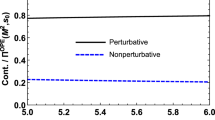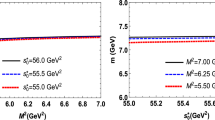Abstract
We discuss the scenario where the X(3872) resonance is the \(c\bar c\) = χc1(2P) charmonium which “sits on” the D*0\({\bar D^0}\) threshold. We explain the shift of the mass of the X(3872) resonance with respect to the prediction of a potential model for the mass of the χc1(2P) charmonium by the contribution of the virtual D*\(\bar D\) + c.c. intermediate states into the self energy of the X(3872) resonance. This allows us to estimate the coupling constant of the X(3872) resonance with the D*0\({\bar D^0}\) channel, the branching ratio of the X(3872) → D*0\({\bar D^0}\) + c.c. decay, and the branching ratio of the X(3872) decay into all non-D*0\({\bar D^0}\) + c.c. states. We predict a significant number of unknown decays of X(3872) via two gluon: X(3872) → gluongluon → hadrons. We suggest a physically clear program of experimental researches for verification of our assumption.
Similar content being viewed by others
References
N. N. Achasov and E. V. Rogozina, Mod. Phys. Lett. A 30, 1550181 (2015).
R. Aaij et al. (LHCb Collab.), Eur. Phys. J. C 72, 1972 (2012).
K. A. Olive et al. (Particle Data Group), Chin. Phys. C 38, 090001 (2014).
C.-Z. Yuan (Belle Collab.), “XXIX Physics in Collision: Proc. of the International Symposium Held in Kobe, Japan, 30 August–2 September 2009” (Universal Academy Press, 2009); arXiv:0910.3138[hep-ex].
S. K. Choi et al. (Belle Collab.), Phys. Rev. D 84, 052004 (2011).
N. N. Achasov and E. V. Rogozina, JETP Lett. 100, 227 (2014).
R. Aaij et al. (LHCb Collab.), Nucl. Phys. B 886, 665 (2014).
N. N. Achasov and E. V. Rogozina, arXiv:1510.0735[hep-ph].
Author information
Authors and Affiliations
Corresponding author
Additional information
The article is published in the original.
Talk at International Session-Conference of the Section of Nuclear Physics of PSD RAS “Physics of Fundamental Interactions”, Section “Physics of Flavors, Hadrons, Exotics”, JINR, Dubna, April 12–15, 2016.
Rights and permissions
About this article
Cite this article
Achasov, N.N. Why X(3872) is not a molecule. Phys. Part. Nuclei 48, 839–840 (2017). https://doi.org/10.1134/S1063779617060028
Published:
Issue Date:
DOI: https://doi.org/10.1134/S1063779617060028




